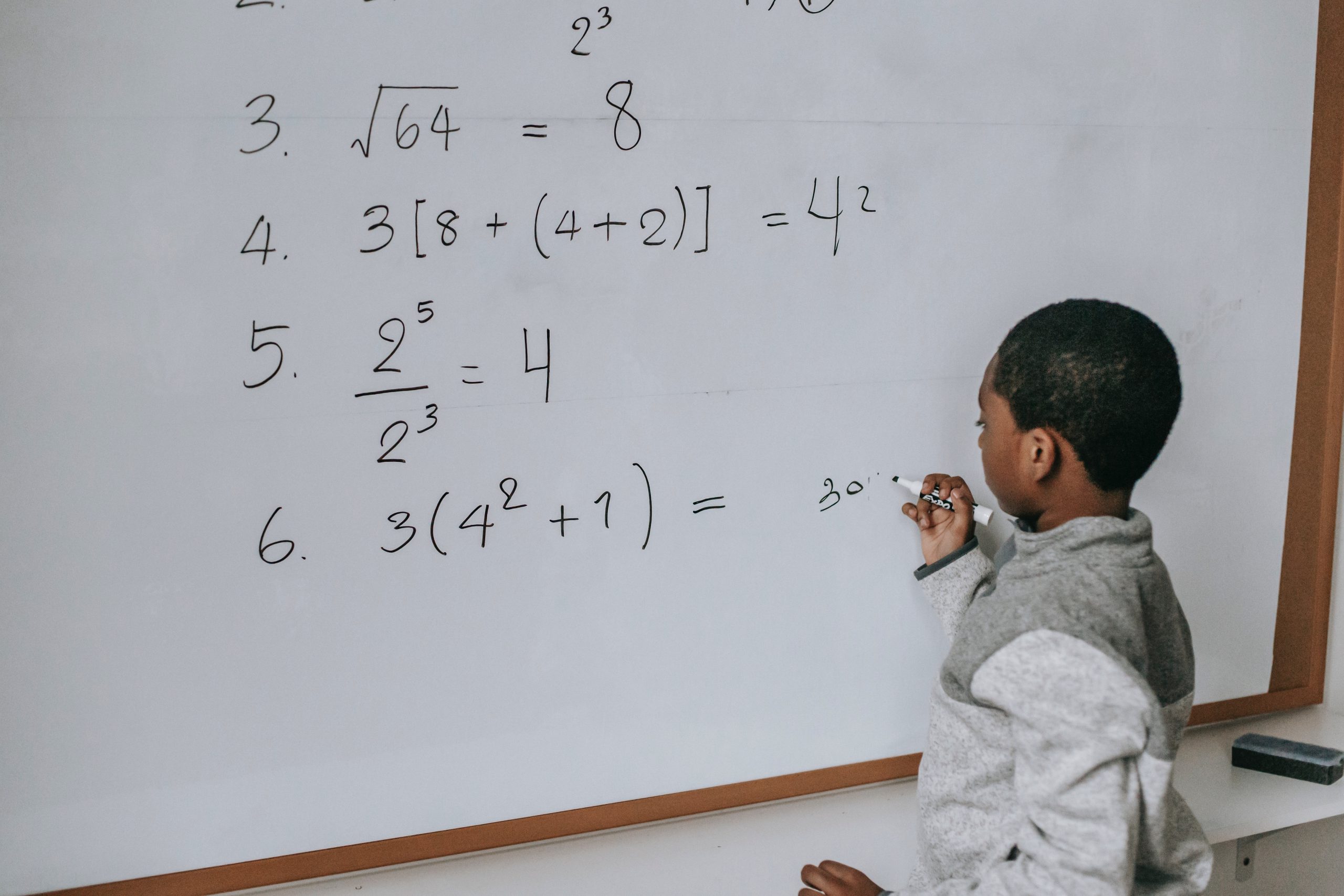

Last Updated on August 3, 2023
Is your fifth grade student struggling in math? Perhaps fractions are giving them trouble, or they just can’t figure out decimals.
Maybe you’re noticing that their academic confidence is dropping, and they’re no longer enjoying school the way they used to.
It’s never easy to see your child struggling with an academic subject—especially one that’s as core to learning as mathematics. Homework can become tedious and frustrating, upcoming tests can cause anxiety, and your child’s social and extracurricular life can suffer, too.
If you’re like most parents in this situation, this is the point at which you’ve probably considered hiring a math tutor. But how do you find one who’s a good fit—a 5th grade math tutor who will really help your child succeed in their math classes and grow their math skills?
And once you have the tutor, how do keep that learning process working outside of tutoring time?
We’re here to answer those questions.
You could say that everything your child learns in school is critical to their long-term success, and in a way, you would be right.
After all, everything a child learns is built on what they learned before. If your student didn’t do well in second grade math, it stands to reason that they’re going to need a bit more help learning more complex, third-grade concepts. Likewise, what they learn in fifth-grade math will have an impact on what they’re able to understand in sixth grade, as well as on their overall middle school GPA.
However, fifth grade math skills may actually be one of the most important elements of your child’s education. Consider this: in fifth grade, the last year of elementary school, students get comfortable with fundamental, real-world math concepts like:
–Decimals
–Fractions
–Geometric principles
–Units of measurement
If your 5th grader doesn’t have a firm grasp of these concepts by the time they’re finished with fifth grade, they could struggle in math long-term-not to mention, they’ll be at a disadvantage as young adults the next time they want to help a friend build a table or estimate their monthly expenditures!
For some quick practice, download Thinkster’s fifth grade math worksheet here.
A math tutor for your fifth grader should have a firm foundation in all the basic mathematical concepts they’ll be studying, as well as be able to engage your student and keep their attention.
One of the most important things to look for in a math tutor-and it’s something all Thinkster math tutors already possess-is a background in math education.
Our tutors are all math educators, which means they’re experienced in communicating math concepts to students in ways that are fun, interesting, and easy to understand.
A great math tutor will:
–Act like a math coach, not just a tutor
–Develop a trusting, long-term relationship with your child
–Put in the effort required to figure out exactly what math skills your student doesn’t understand
–Motivate your student to put in the effort required to improve their own math skills to grade level or beyond
–Deliver a fun, engaging learning experience
In 5th grade math, kids start preparing for a deeper understanding of algebraic concepts. Common Core requires them to be able to write and understand numerical expressions using parentheses, brackets or braces. They should also be able to use equations to represent word problems and write simple equations with variables. The basic properties of addition and multiplication are also required.
Students in 5th grade math are going to spend a lot of time analyzing and working with tables and graphs. They will begin graphing linear functions and using coordinate graphs, and will work with function tables as well. They also need to be able to find patterns, continue them, and graph the results.
By fifth grade, students should be well-versed in recognizing the place-value system and identifying values in specific places. They also should be able to multiply, divide, subtract and add. In fifth grade, they will begin working even more with decimals and will be making the connection between decimals and the fraction equivalents. Furthermore, they will also learn scientific notation and will work with decimals and fractions in expanded form. Lastly, rounding and estimating with decimals is also important.
This is not the first year students will be multiplying and dividing, but in 5th grade math, the numbers are going to get larger. You will also find that the word problems associated with multiplication and division become increasingly complex, with multiple steps often required.
This is the year when work with fractions becomes intense. Students will be learning how to do various operations with fractions and mixed numbers, including adding and subtracting with unlike denominators. Borrowing and carrying with fractions is also taught in fifth grade. Students will also be asked to use real-world examples and models to help with fractions.
5th grade geometry will include coordinate graphs and graphing points on a plane. Students will need to be able to classify quadrilaterals and work with both regular and irregular polygons.
Geometry and measurement will be working closely together in 5th grade math, as students will be finding volume and area of shapes and prisms of many different sizes. They will also be comparing and converting units of measurement from one unit to the next.
Does this list seem overwhelming to you? Are you wondering whether or not you remember all of these concepts? If you want to give your child the best chance of success at 5th grade math, even with limited knowledge on your part, then consider an online tutoring option that will give them the boost they need.
Thinkster Math offers online tutoring that your child can tap into whenever you have time. Created by teachers with today’s math standards in mind, Thinkster provides instruction at the point of learning for greater success. This can be the tool that you need to give your child a chance at success with challenging 5th grade math concepts.
That depends, of course on your student. Some fifth graders will find the order of operations to be confusing or challenging, while others will struggle with fractions. Every student has their own strengths and weaknesses.
The important thing to remember, especially when looking for a math tutor for your fifth grade student, is that you need someone who will meet your child exactly where they are. You need a math tutor, whether an in-person tutor or an online math tutor, who will work with your child’s strengths, and help them develop in the areas where they may have weaknesses.
Personalization is critical—that’s why Thinkster’s online math tutoring program combines both AI and one-on-one sessions with a human math tutor in order to provide your fifth grade student with exactly the help they need.

Fun and interactive activities are a great way to reinforce important math concepts. Whether your child is struggling or looking to practice more challenging concepts, try these ideas to help your child succeed and master fifth grade math word problems.
1. Draw Pictures
One reason many students have trouble with 5th grade math word problems is that they are not properly visualizing the problem. They don’t know what to do because they can’t picture what the problem is asking them to do.
You can help by encouraging your child to draw pictures. The picture does not have to be to scale or even fully accurate, but it can give your fifth grader a starting point to figure out the processes required to solve the problem. By visualizing the word problem, you can help your student better grasp what needs to be done.
To make this even more fun as an after-school activity, take it outside! Use your driveway and some sidewalk chalk for a fun way to visualize word problems.
2. Cook Together
To kids, cooking may seem unrelated to math, but it actually involves many math concepts, such as fractions, division, and multiplication.
Cook or bake with your child and create basic math word problems for them to solve.
For instance, you can bake a batch of cookies and tell your child, “we are going to double this recipe.” Then, have him double each amount. Some problems may be easy to solve, such as two cups of flour becomes four, but others involving fractions are not as simple.
3. Home Improvement Projects
Many homes have plenty of house projects that need to be tackled. Finding the time, energy, and money to do so might be difficult, but that doesn’t mean your fifth-grader can’t help!
For example, if he wants to repaint his room, direct him to figure out the area of his walls, how much paint will be needed, how much that paint will cost, and how much estimated time the job will require.
He will be applying math skills to a real-world problem, which ultimately helps him with 5th grade word problems. Then, when you do get around to painting his room or any other planned projects, he will be more eager to help!
4. A Trip to the Store
Shopping at a retail or grocery store is a great way to have your child practice math.
Give your fifth grader a shopping list and a budget, then let her do the shopping while you push the cart.
Be a little vague about how much of each item you need so that she must determine what she can afford. Allow for some wiggle room so she can buy a treat, but again, ask her to use her estimation skills to decide if she will have enough money for that treat.
If your fifth grader is advanced and eager for a challenge, you can also have her calculate sales tax on the purchase!
5. Party Planning
Kids love parties, and though you obviously can’t let them throw unlimited bashes, you can let them plan as many as they want!
Give your child a budget and challenge him or her to come up with a menu, party favors, and decorations that will keep them within their budget. For example, your fifth-grader may want to order specialty pizzas instead of just going to Pizza Hut -how will that decision affect what other food can be served and how many guests can ultimately be invited?
Your child will use essential math skills while discovering how challenging the task of planning a party can be.
6. Help Develop Problem-Solving Plans
Another way to help kids think through word problems is to teach them to use a problem-solving plan. This is a four-step plan that can help them conquer word problems.
It involves:
1. Understanding the problem
2. Devising a plan
3. Carrying out the plan
4. Going back to check work
Students must first read and understand the problem, then create and carry out a plan.
The final step, checking their work, is crucial because it is what helps them determine if their answer and plan make sense. The more your child uses this process with 5th grade math word problems, the better equipped she will be.
To make this an activity, give your child some fun word problems and work through the four steps together.
7. Use Technology to Help Master Math Word Problems
If your kids are running to the tablet or computer after school, enroll in an engaging, tech-based tutoring program to help with word problems. With the right math learning program, your children can be motivated, engaged and even entertained while learning and developing crucial math skills.

If you see your fifth grader is struggling in math class, then it may be time to look for a tutor.
But even children who are doing well in math during this crucial year can benefit from tutoring. That’s because it’s possible to get a good grade without fully understanding the underlying math concepts that are presented. With tutoring, a child who does well in fifth grade math can become a child who excels at math in middle school and beyond.
If you do decide to hire a tutor for your fifth grader, just be sure that you’re getting a level of service that will actually make a difference in your child’s learning and understanding.
Daily monitoring and feedback is best, since it can be easy for a child to put off their practice until the last minute if they know there will be a check-in on a specific day. A dedicated tutor can make sure that children learn and practice at a steady, achievable pace without forgetting everything they learned last week.
That’s why at Thinkster, our tutors offer concierge-level service seven days a week. Learning doesn’t just happen once or twice a week-it’s a continuous, evolving process. Our seven step method ensures your child gets a personalized plan that puts them on the path to becoming a math champion!
When shopping for a program, look for one that is personalized to your child’s level of learning. This ensures that your child gets the exact practice needed for fifth grade math word problems. Thinkster Math is a program created by teachers that personalizes instruction for each child.
Plus, it’s a fun and exciting way to reinforce math skills after school!
Curious what the full fifth-grade math curriculum includes? We’ve included it below.
Building & Placement of Decimals
Decimal Addition & Subtraction
Logical Reasoning Word Problems


